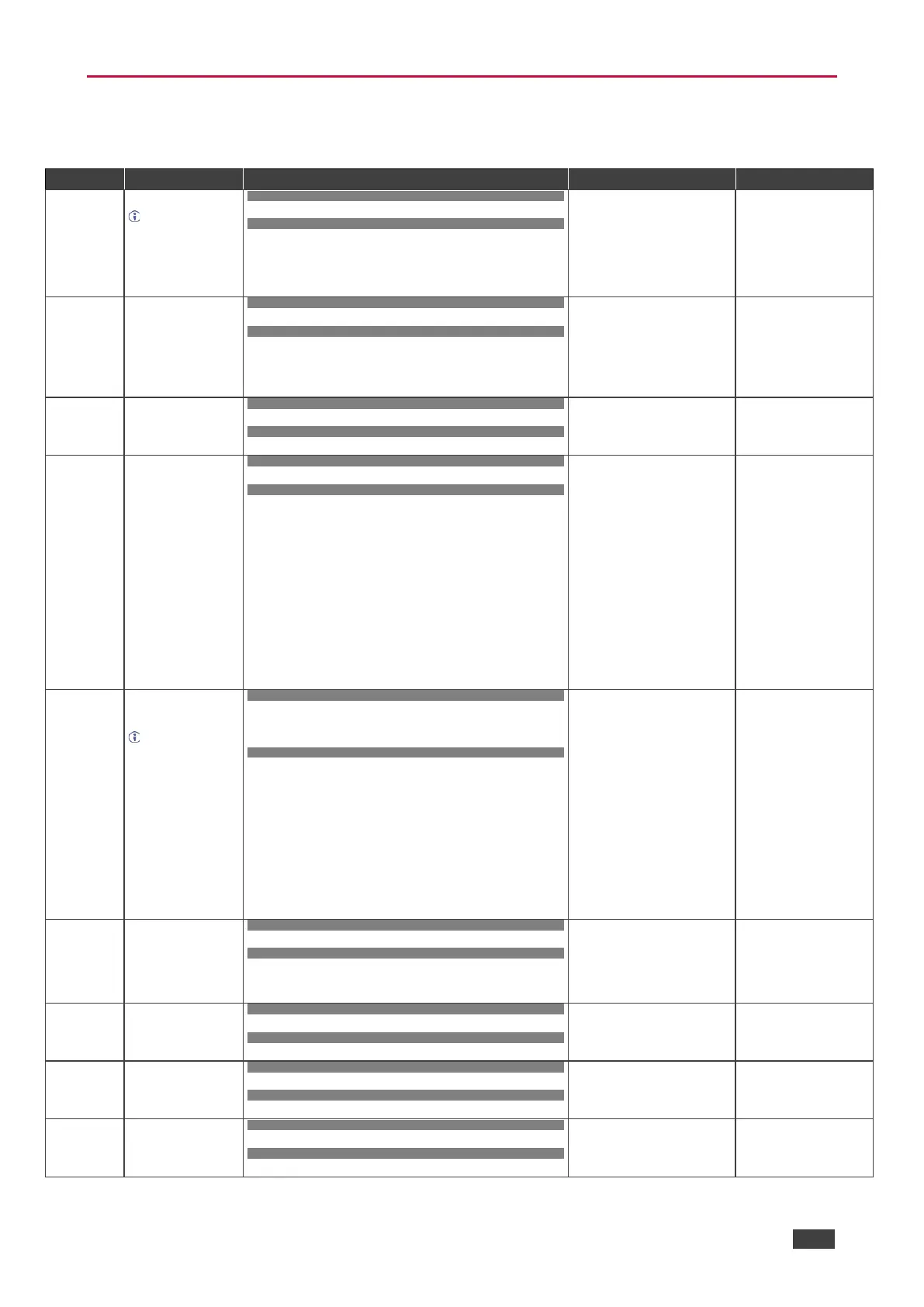Protocol handshaking.
Validates the Protocol
3000 connection and gets
the machine number.
Step-in master products
use this command to
identify the availability of a
device.
COMMAND
#<CR>
FEEDBACK
~nn@OK<CR><LF>
COMMAND
#BUILD-DATE?<CR>
FEEDBACK
~nn@BUILD-DATEdate,time<CR><LF>
date – Format: YYYY/MM/DD where
YYYY = Year
MM = Month
DD = Day
time – Format: hh:mm:ss where
hh = hours
mm = minutes
ss = seconds
Get the device build date:
#BUILD-DATE?<CR>
COMMAND
#CECstate<CR>
FEEDBACK
~nn@CECstate<CR><LF>
Set display to OFF via CEC:
#CEC-ON<CR>
Send CEC command to
port.
COMMAND
#CEC-SNDport_num,cmd_id,cmd_name,len,cec_command<CR>
FEEDBACK
~nn@CEC-SNDport_num,cmd_id,cmd_name,status<CR><LF>
port_num – CEC port transmitting
the command: 1
cmd_id – serial number of command
for flow control and response
commands from device: 0-255
cmd_name – command name
len – 1–16
cec command – CEC format
command (in HEX format, no leading
zeros, no ‘0x’ prefix)
status –
0 – Sent
1 – Gateway disabled
2 – Inactive CEC-Master
3 – Busy
4 – Illegal Message Parameter
5 – Illegal CEC Address Parameter
6 – Illegal CEC Command
7 – Timeout
8 – Error
Send a display ON command:
#CEC-SND 1,1,ON,2,E0
04<CR>
Copy EDID data from the
output to the input
EEPROM.
Destination bitmap
size depends on device
properties (for 64 inputs it
is a 64-bit word).
Example: bitmap 0x0013
means inputs 1,2 and 5
are loaded with the new
EDID.
In certain products
Safe_mode is an optional
parameter. See the HELP
command for its
availability.
COMMAND
#CPEDIDsrc_type,src_id,dst_type,dest_bitmap<CR>
or
#CPEDIDsrc_type,src_id,dst_type,dest_bitmap <CR>
FEEDBACK
~nn@CPEDIDsrc_stg,src_id,dst_type,dest_bitmap<CR><LF>
~nn@CPEDIDsrc_stg,src_id,st_type,dest_bitmap<CR><LF>
src_type – EDID source type
(usually output)
0 – Input
1 – Output
2 – Default EDID
src_id – Number of chosen source
stage
1 – Output
dst_type – EDID destination type
(usually input)
0 – Input
dest_bitmap – Bitmap representing
destination IDs. Format: XXXX…X,
where X is hex digit. The binary form
of every hex digit represents
corresponding destinations.
0 – indicates that EDID data is not
copied to this destination.
1 – indicates that EDID data is
copied to this destination.
Copy the EDID data from the
Output 1 (EDID source) to the
Input:
#CPEDID1,1,0,0x01<CR>
Copy the EDID data from the
default EDID source to the
Input:
#CPEDID2,0,0,0x01<CR>
COMMAND
#DISPLAY?out_id<CR>
FEEDBACK
~nn@DISPLAYout_id,status<CR><LF>
out_id – Output number
1 – Output
status – HPD status according to
signal validation
0 – Signal or sink is not valid
1 – Signal or sink is valid
2 – Sink and EDID is valid
Get the output HPD status of
Output 1:
#DISPLAY?1<CR>
COMMAND
#ECHOstatus <CR>
FEEDBACK
~nn@ECHOstatus OK<CR><LF>
status – ???
0 – Echo off
1 – Echo on
Set echo status to on:
#ECHO1<CR>
COMMAND
#ECHO?<CR>
FEEDBACK
~nn@ECHOstatus<CR><LF>
status –
0 – Echo off
1 – Echo on
Get Echo status:
#ECHO?<CR>
Set Ethernet port protocol.
COMMAND
#ETH-PORTportType,ETHPort<CR>
FEEDBACK
~nn@ETH-PORTportType,ETHPort<CR><LF>
portType – TCP/UDP
0 – TCP
1 – UDP
ETHPort – TCP/UDP port number
Set the Ethernet port protocol
for TCP to port 12457:
#ETH-PORT0,12457<CR>

